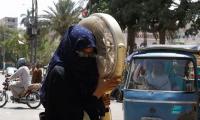The Covid-19 pandemic has worsened an already-stretched, substandard and often defunct public education service delivery system in Pakistan.
Access to quality and equitable education continues to be elusive to many children, especially for girls from low-income families and for other marginalised groups.
Issues of regional inequalities, poverty, social conservatism are the most common exogenous factors affecting public education system across the country, but these challenges get worse in merged districts of Khyber Pakhtunkhwa (previously known as Fata).
The fragile context of the region resulting from decades of radicalisation, terrorism, military operations and forced displacements has resulted in a serious learning gap.
Estimates from the Pakistan Education Statistics’ Report 2016-17 suggest that 57 percent of children in the tribal districts are not attending schools. Of those who are enrolled, 73 percent drop out by the time they reach grade 5. The indicators are worse off for girls as the Gender Parity Index (GPI) in the newly merged districts is 0.56 (56 girls for every 100 boys), compared with 0.77 in the settled districts. According to the Annual Status of Education Report (ASER) 2018, scores in reading – both English and Urdu/Pashto – are among the lowest in the country.
Coupled with this are the supply side issues involving poor governance practices and lack of school infrastructure making education service delivery a huge and complex responsibility for the state to fulfill. This creates an opportune space for the private sector to step in through a public private partnership (PPP) model. Well-designed, tailored and targeted PPPs have evidently proven to improve access and learning outcomes for vulnerable groups.
Such models mandate the government to provide finances, oversight and policy guidance to private schools while allowing them to manage their day-to-day operations. While higher academic achievement among private school students compared to those from public schools is common knowledge, evidence also suggests that students from publicly funded, private institutions achieve higher academic scores than those from public institutions.
The provincial government of Khyber Pakhtunkhwa has been keen to implement innovative alternate solutions to cater to the educational needs of the region, but tailored PPP models have yet to be implemented at scale. PPP models offer greater autonomy in managing schools including flexibility in teacher contracting, which is often the biggest pain point in the public sector schools. The model can also allow flexibility in incentive provisions, especially to girls through provision of meals, stipends or vouchers, transport facilities etc which work rules of the public sector often do not allow.
The conundrum of improving girls’ access to schools especially because of social conservatism and general apprehension towards their education would stand out as the biggest challenge in merged areas. Localised educational services delivered through community-supported initiatives have previously worked in countries like India, Bangladesh, Afghanistan and Colombia.
Results from a study by the Brookings Institution in 2015 showed that community-based schooling models implemented at a small scale in the socially conservative region of Diamer and fragile region of Mohmand resulted in an increase in enrollment, especially for girls, by 75 percent and 51 percent respectively. In both these models, a coordinated response was curated through engaging community elders, religious leaders, political representatives, civil society activists along with the government authorities especially the police departments. Local school staff were hired, including female teachers and security personnel from the community.
Pakistan has been a hub for educational experiments with new products being launched from time to time, which is encouraging as it shows the government’s eagerness for change. However, the context of the merged areas continues to be complex so, instead of waiting for the ‘next big thing’, it might be worthwhile to do more of what has worked in the past in such fragile contexts.
The PPP initiatives allow flexibility to incorporate community-supported initiatives while matching the scale of the public sector. The model has the potential to offer flexible, responsive and cost-effective learning pathways for students, especially girls, in the merged areas.
The writer is a graduate of the Harvard Graduate School of Education and works for Oxford Policy Management as an education consultant.
Twitter: @sabeen00
Punjab, with its population of over 120 million, stands at a critical juncture in its history
Events leading up to the upcoming protests and beyond are a powerful reminder of Pakistan’s once relatively...
Efforts are alas now being made to fragment the HEC and hand over the pieces to the provinces
Pakistan’s total electricity consumption, as measured in terms of sales, has decreased to 112.9 TWh in FY2023 from...
Any progressive society or government will uphold security so that people can utilize their full potential
In Pakistan, we have witnessed erosion of public trust in government institutions







